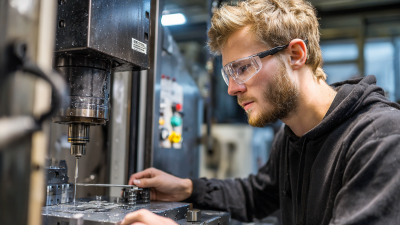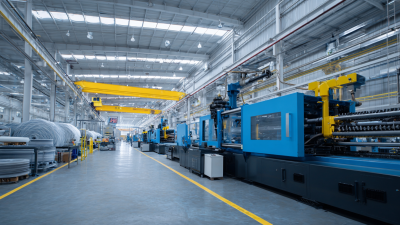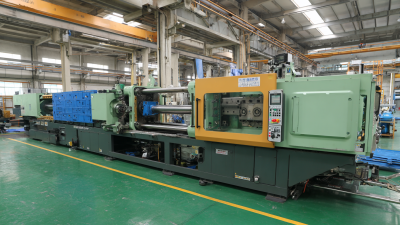Exploring Innovative Alternatives in Plastic Engineering Solutions
As the world grapples with the consequences of plastic pollution, the need for sustainable solutions in plastic engineering has never been more urgent. According to a report by the World Economic Forum, by 2030, the demand for plastic materials could reach 1.3 billion tons annually, driving a staggering increase in waste if innovative practices are not adopted. The plastic engineering sector is poised for a transformation, with emerging technologies and alternative materials offering promising paths forward. A study published by McKinsey & Company highlights that the global market for bioplastics alone is projected to reach $54 billion by 2025, showcasing a shift towards environmentally friendly solutions. This blog will explore the latest advancements and initiatives in plastic engineering, highlighting innovative alternatives that not only reduce environmental impact but also redefine the industry’s approach to sustainability.

Emerging Materials in Plastic Engineering: Trends and Market Insights
The field of plastic engineering is undergoing a significant transformation as innovative materials emerge to meet the growing demand for sustainability and functionality. Trends show a shift toward bioplastics, which are derived from renewable resources such as cornstarch and sugarcane. These materials not only reduce dependence on fossil fuels but also offer biodegradability, addressing the urgent issue of plastic waste. Additionally, advanced composites combining natural fibers with polymers are gaining traction, enhancing the strength and lightweight attributes of plastic products.
Market insights indicate that industries are increasingly investing in research and development to explore these emerging materials. The automotive sector, for instance, is adopting lightweight biocomposites to improve fuel efficiency while maintaining structural integrity. Similarly, the packaging industry is implementing innovative materials that offer enhanced barrier properties while being environmentally friendly. As consumer awareness regarding environmental issues grows, companies are compelled to prioritize sustainable practices, leading to a surge in the adoption of innovative alternatives in plastic engineering.

Sustainable Innovations: Biodegradable Plastics and Their Environmental Impact
The concept of biodegradable plastics has gained significant traction in recent years, driven by increasing consumer awareness and environmental concerns. According to a 2021 report by Smithers Pira, the market for biodegradable plastics is expected to reach approximately $6.5 billion by 2024, growing at a compound annual growth rate (CAGR) of 16% from 2019. This surge is largely attributed to innovations in material science, enabling the development of plastics that decompose more quickly than traditional petroleum-based alternatives.

A notable advancement in this realm is the formulation of polylactic acid (PLA), a bioplastic derived from renewable resources like corn starch. Research indicates that PLA can decompose in industrial composting facilities within 60 to 90 days, significantly reducing landfill waste compared to conventional plastics, which can persist for hundreds of years. Furthermore, a study published in the journal "Environmental Science & Technology" reveals that replacing just 10% of conventional plastics with biodegradable alternatives could prevent the release of over 1 million tons of carbon dioxide annually. Such data highlights the crucial role of sustainable innovations in tackling plastic pollution and promoting a circular economy.
Advanced Manufacturing Techniques: 3D Printing and Its Role in Plastic Solutions
In recent years, 3D printing has emerged as a game-changing technology in plastic engineering, offering innovative solutions that enhance design flexibility and reduce material waste. According to a report by the Wohlers Associates, the global 3D printing market is projected to reach $34.8 billion by 2024, with the plastics segment dominating, accounting for approximately 61% of total additive manufacturing material production. This shift toward additive technologies allows manufacturers to create complex geometries that were previously impossible with traditional methods, thus opening up new avenues in product development.
Advanced manufacturing techniques such as 3D printing enable rapid prototyping, allowing engineers to iterate designs more swiftly and effectively. A study conducted by MIT's Self-Assembly Lab revealed that 3D printing can reduce production time by up to 90% compared to conventional fabrication methods, significantly speeding up the time-to-market for new products. Furthermore, the ability to customize products on-demand aligns perfectly with the growing trend toward personalized consumer experiences, driving both efficiency and satisfaction in plastic solutions across various industries.
Recycling Revolution: Circular Economy Practices in Plastic Engineering
The landscape of plastic engineering is undergoing a significant transformation, driven by the need for sustainable practices and a circular economy model. The recycling revolution is at the forefront of this change, encouraging industries to rethink their approach to plastic waste. By embracing circular economy principles, companies are now developing innovative recycling methods that ensure plastics are not just discarded, but repurposed and reintegrated into the production cycle. This shift not only minimizes environmental impact but also promotes resource efficiency, which is essential in tackling the global plastic crisis.
Revolutionary recycling technologies are making it possible to convert various types of plastic waste back into high-quality raw materials. For instance, chemical recycling processes can break down plastics into their original monomers, allowing for them to be remade into new products. Additionally, enhanced sorting and processing techniques are improving the recovery rates of plastics, supporting a steady supply of recycled materials for manufacturers. As these practices become more widespread, they are increasingly seen as integral to the future of plastic engineering, offering a pathway to sustainable production and consumption patterns that align with the principles of a circular economy.
Exploring Innovative Alternatives in Plastic Engineering Solutions - Recycling Revolution: Circular Economy Practices in Plastic Engineering
| Material Type | Recycling Rate (%) | Energy Savings (%) | CO2 Emissions Reduction (kg/ton) | Applications |
|---|---|---|---|---|
| Polyethylene (PE) | 30 | 20 | 1,500 | Packaging, Containers |
| Polypropylene (PP) | 25 | 12 | 1,200 | Automotive Parts, Textile |
| Polyvinyl Chloride (PVC) | 15 | 10 | 900 | Pipes, Profiles |
| Polystyrene (PS) | 20 | 15 | 1,000 | Disposable Containers, Insulation |
| Polyethylene Terephthalate (PET) | 35 | 25 | 1,700 | Bottles, Clothing |
Performance Metrics: Analyzing the Effectiveness of Alternative Plastics in Industry Applications
The exploration of alternative plastics in industry applications is gaining momentum, particularly with the increasing scrutiny of traditional plastic use. Recent studies indicate a marked shift towards sustainable materials, with a 22% growth in bioplastics market share projected by 2025. This shift is fueled by advancements in biodegradable options, highlighting materials like polyhydroxyalkanoates (PHAs), which could potentially revolutionize packaging solutions by offering both functionality and environmental benefits.
To effectively analyze the performance metrics of these alternatives, companies can employ a systems approach that assesses the entire value chain—from production to end-of-life management. The growing interest in agriplastics, particularly within crop cultivation, has demonstrated potential benefits, with some innovative application estimates suggesting a 30% increase in crop yield when using advanced biodegradable plastic films.
**Tips**:
1. Evaluate your current supply chain to identify opportunities for integrating sustainable plastics and biopolymers, thereby enhancing your brand's commitment to environmental responsibility.
2. Stay updated on technological innovations that can improve the recycling efficiency of alternative plastics, as energy efficiency remains a critical challenge in achieving effective circularity.
3. Engage with stakeholders to promote awareness about the benefits of transitioning to biodegradable materials, which can foster more sustainable industry practices.
Effectiveness of Alternative Plastics in Industry Applications
Related Posts
-

Exploring Unique Product Features and Applications in Best Plastic Injection Mold Tooling
-

Common Challenges in the Best Plastic Injection Moulding Process
-

The Future of Precision Injection Molding Innovations and Trends
-

How to Optimize Your Injection Molding Tooling Processes for Maximum Efficiency
-

The Ultimate Guide to Mastering Best Polyethylene Injection Molding Techniques
-

How to Choose the Best Injection Molding Die for Your Production Needs: Insights from Industry Experts
